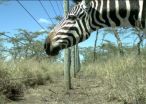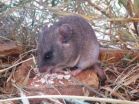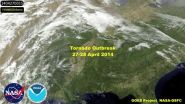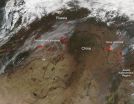(Press-News.org) Populations of large wildlife are declining around the world, while zoonotic diseases (those transmitted from animals to humans) are on the rise. A team of Smithsonian scientists and colleagues have discovered a possible link between the two. They found that in East Africa, the loss of large wildlife directly correlated with a significant increase in rodents, which often carry disease-causing bacteria dangerous to humans. The team's research is published in the Proceedings of the National Academy of Sciences, April 28.
"Our study shows us that ecosystem health, wildlife health and human health are all related," said Kristofer Helgen, curator of mammals at the Smithsonian's National Museum of Natural History and co-author of the research.
Large animals, such as elephants, giraffes, antelope and zebras, have a profound influence on their ecosystems by feeding on vast amounts of vegetation and compacting and disturbing soil. As populations of these large species decline, the ecosystems they once dominated change in many ways. The team's main question was whether the loss of large wildlife influences the risk of people contracting diseases spread by rodents—a pressing question, as more than 60 percent of infectious human diseases are zoonotic.
"Understanding the linkages between biodiversity loss and zoonotic disease is important for both public health and nature conservation programs," said Hillary Young, former Smithsonian post-doctoral fellow and current assistant professor at the University of California, Santa Barbara. "While this correlation has been the topic of much scientific debate, ours is one of the only studies to offer clear experimental evidence." Young is the lead author of the research paper.
Using 24 acres of savanna that had been fenced off for 15 years to keep large animals out in central Kenya, the scientists examined rodent populations inside and outside the area for three years. They also tracked the presence of Bartonella infections in the rodents and their fleas. Bartonella, a group of bacteria found around the world, can cause bartonellosis in humans—an infectious disease that can lead to joint swelling, liver damage, memory loss and other symptoms.
The team regularly trapped rodents in the area, represented by several species of mice, rats and gerbils. Each rodent was identified to species, sexed, weighed and marked. A blood sample and fleas, if they were present, were collected from each rodent for testing before it was released where it was captured.
The team found that rodent and, consequently, flea abundance doubled inside the area that excluded large wildlife. Without having to compete with large animals for food, the rodent population grew twofold. When the rodents and fleas in the area doubled, the team found that those infected with Bartonella doubled as well.
The removal of large wildlife from the ecosystem could be directly linked to the increase in rodents and the rodent-borne disease, thus increasing risk to humans. These results suggest that a partial solution to problems of rodent-borne disease could come in the form of wildlife conservation.
"Africa's large wildlife faces many threats—elephants, rhinos and other large mammals continue to decline in the face of growing human populations, expanding agriculture and the impacts of poaching and wildlife trade," said Helgen. "While we know that conservation is good for wildlife and for economies reliant on tourism, our study shows a less-intuitive dimension of conservation that could greatly benefit the people living alongside wildlife."
This study is the first of several more to come. The team plans to expand its research to a wider suite of infectious diseases to see which might respond similarly and which do not. They will also undertake further studies not only in carefully controlled experimental sites but in the "real world" where humans have already altered the landscape and eradicated much of the large wildlife.
The team's research has implications well beyond Africa. "While rodent-borne diseases are a major issue in Africa, they are everywhere—Europe, Asia, North and South America," Young said. "What we find here may very well be applicable in other parts of the world."
INFORMATION: END
Decrease in large wildlife drives an increase in rodent-borne disease and risk to humans
2014-04-28
ELSE PRESS RELEASES FROM THIS DATE:
Smart home programming: Easy as 'if this, then that'
2014-04-28
PROVIDENCE, R.I. [Brown University] — The idea of a smart home sounds promising enough. Who doesn't want a house full of automated gadgets — from light switches to appliances to heating systems — that know exactly when to turn on, turn off, heat up or power down?
But in order for all those devices to do what they're supposed to do, they'll need to be programed — a task the average homeowner might not have the interest or the tech-savvy to perform. And nobody wants to call tech support just to turn on a light.
A group of computer science researchers from Brown and Carnegie ...
Satellite movie shows US tornado outbreak from space
2014-04-28
VIDEO:
This animation of NOAA's GOES-East satellite data shows the development and movement of the weather system that spawned tornadoes affecting seven central and southern US states on Apr. 27-28, 2014....
Click here for more information.
NASA has just released an animation of visible and infrared satellite data from NOAA's GOES-East satellite that shows the development and movement of the weather system that spawned tornadoes affecting seven central and southern U.S. states ...
NIH scientists establish monkey model of hantavirus disease
2014-04-28
WHAT: National Institutes of Health (NIH) researchers have developed an animal model of human hantavirus pulmonary syndrome (HPS) in rhesus macaques, an advance that may lead to treatments, vaccines and improved methods of diagnosing the disease. The study, conducted by researchers at NIH’s National Institute of Allergy and Infectious Diseases (NIAID), is published in the Proceedings of the National Academy of Sciences.
People become infected with hantaviruses by inhaling virus from the urine, droppings or saliva of infected rodents. This infection can progress to HPS, ...
A water test for the world
2014-04-28
HAMILTON, April 28, 2014 – Inspiration can come in many forms, but this one truly was a breath of fresh air.
A group of McMaster researchers has solved the problem of cumbersome, expensive and painfully slow water-testing by turning the process upside-down.
Instead of shipping water to the lab, they have created a way to take the lab to the water, putting potentially life-saving technology into the hands of everyday people.
The team has reduced the sophisticated chemistry required for testing water safety to a simple pill, by adapting technology found in a dissolving ...
Technological advancements extend survival of transplanted hearts across species
2014-04-28
The use of transplant organs from animals (xenotransplantation) could help to compensate for the shortage of human organs available for transplant. NIH researchers have demonstrated that by using hearts from genetically engineered pigs in combination with target-specific immunosuppression of recipient baboons, organ survival can be significantly prolonged. This has potential for paving the way for the use of animal organs for transplantation into humans.
Toronto, ON, Canada, April 28, 2014 – Cardiac transplantation is the treatment of choice for end stage heart failure. ...
Disney Researchers use 3-D printing to produce interactive speakers of any shape
2014-04-28
Forget everything you know about what a loudspeaker should look like. Scientists at Disney Research, Pittsburgh have developed methods using a 3D printer to produce electrostatic loudspeakers that can take the shape of anything, from a rubber ducky to an abstract spiral.
The simple speakers require little assembly, but even those few manual steps might be eliminated in the future, said Yoshio Ishiguro, a Disney Research, Pittsburgh post-doctoral associate. "In five to 10 years, a 3D printer capable of using conductive materials could create the entire piece," he predicted.
The ...
Well-informed patients key to accepting gene-based drug dosing
2014-04-28
A new study out of Western University (London, Canada) illustrates the need for a lot more education around pharmacogenetics (PGx) –the study of how a patient's genes can affect drug reaction and dosage. PGx promises to optimize patient response to therapy, but this is the first study to really investigate how patients perceive this kind of genetic testing, and whether those perceptions differ when it comes to parents and their children. The research, led by Dr. Michael Rieder of Western's Schulich School of Medicine & Dentistry is published in the journal Pediatrics.
"Pharmacogenetic ...
The thin-crusted US Sierra Nevada Mountains: Where did the Earth go?
2014-04-28
Boulder, Colo., USA – In an addition to Geosphere's ongoing themed issue series, "Geodynamics and Consequences of Lithospheric Removal in the Sierra Nevada, California," Craig H. Jones of the University of Colorado Boulder and colleagues examine the seismological study of the entire extent of the U.S. Sierra Nevada range using seismograms collected in the Sierra Nevada EarthScope field experiment from 2005 to 2007.
The southern Sierra Nevada is known to have unusually thin crust for mountains with such high elevations (peaks higher than 4 km/14,000 ft, and average elevations ...
Precise brain mapping can improve response to deep brain stimulation in depression
2014-04-28
Experimental studies have shown that deep brain stimulation (DBS) within the subcallosal cingulate (SCC) white matter of the brain is an effective treatment for many patients with treatment-resistant depression. Response rates are between 41 percent and 64 percent across published studies to date.
One of the proposed mechanisms of action is the modulation of a network of brain regions connected to the SCC. Identifying the critical connections within this network for successful antidepressant response is an important next step.
A new study using MRI analysis of the ...
Wildfire outbreak in far eastern Russia
2014-04-28
According to the Voice of Russia, "As of Saturday morning, in Russia continue 103 wildfires at 27,412 hectares, including big 26 wildfires in the Far East and in Siberia. On Friday, 147 new fires began at 12,509 hectares, and 150 were extinguished at 5,437 hectares. Emergency situation has been introduced in the regions with most complicated situations - in the Amur region, in the Maritime and Baikal territories. This was according to the EMERCOM's (Emergency Control Ministry) spokesperson Alexander Drobyshevsky.
Satellites (such as Aqua and Terra) have located "1,587 ...








